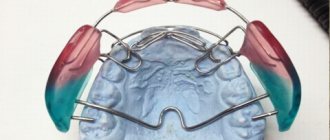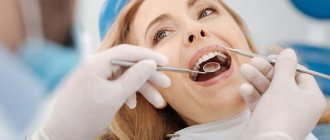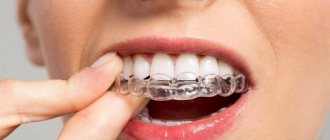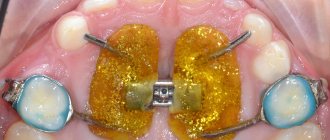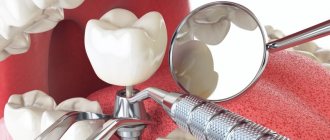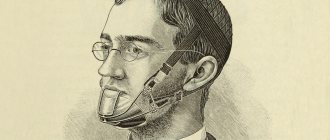Biometric methods for studying diagnostic models of jaws
All patients admitted for orthodontic treatment underwent a study of diagnostic models of the jaws. Diagnostic models were cast from casts obtained using a well-known technique from silicone or alginate materials. The models were cast from ordinary or high-strength plaster. Diagnostic models were measured to make a diagnosis and determine the causes of retention.
Teeth measurements.
Using a special caliper, the mesiodistal dimensions of the crown parts of the teeth were measured. The measurements were carried out in the region of the equator. In all patients, the Tonn index was determined, which reflects the relationship between the sizes of the teeth of the upper and lower jaw:
Sum of width of 4 upper incisors
Index Ton ———————————————— = 1.33
Sum of width of 4 lower incisors
If the ratio is greater than 1.45, it means the patient has individual macrodentia of the upper teeth, which may cause tooth retention. A ratio value less than 1.25 indicates individual macrodentia of the lower teeth.
Measurements of the longitudinal length of the dentition were carried out using the Nance method using a ligature wire, which was placed from the distal surface of the first molar to the distal surface of the first molar of the opposite side, giving the wire the shape of the dentition. In the area of the lateral teeth, the wire was placed in the middle of the chewing surface, and on the front teeth - along their cutting edges. The longitudinal length of the dentition is normally equal to the sum of the mesiodistal dimensions of 12 teeth.
Measuring the dentition.
The transverse dimensions of the dental arches were determined using the Pon method with the Linder-Hart correction, which is based on the relationship between the sum of the mesiodistal dimensions of the 4 upper incisors and the distance between the first premolars and the first molars on the upper and lower jaws. For this purpose, Pon proposed measurement points that normally coincide when the upper and lower jaws are closed. In the area of the first premolars, the width of the dentition, according to Pont, is measured:
- on the upper jaw - between the points in the middle of the intertubercular fissure;
- on the lower jaw - between the distal contact points on the slope of the buccal cusps.
In the area of the first permanent molars, the width of the dentition is measured:
- on the upper jaw - between the points in the anterior recesses of the longitudinal fissure;
- on the lower jaw - between the distal buccal cusps.
Pon derived the premolar and molar indices.
Premolar index=
(Sum of transverse dimensions of 4 upper incisors/distance between premolars) x 100 = 80.
Molar index=
(Sum of transverse dimensions of 4 upper incisors/distance between molars) x 100 = 64.
The obtained measurements are compared with tabular data.
The apical base is a conditional line passing at the level of the apexes of the roots of the teeth in the upper and lower jaws. In the vestibule of the oral cavity, it is projected onto the transitional fold. The width of the apical base is measured using the House method modified by N.G. Snagina.
The width of the apical base of the upper jaw is determined on the plaster model along a straight line between the deepest points in the fossa canina area, and on the model of the lower jaw, the measurement is carried out between the same teeth, departing from the level of the gingival margin by 8 mm. Normally, the width of the apical base of the upper jaw is 44%, the lower - 40% of the sum of the mesiodistal dimensions of the 12 permanent teeth of each jaw.
The discrepancy between the width of the crowns and the size of the apical base can cause dental anomalies, including retention of individual teeth.
To determine the relationship of the dentition in the sagittal direction, Engle's classification was used.
It is based on the type of closure of the first molars. The first class is characterized by normal closure of the molars in the sagittal plane. The mesiobuccal cusp of the first molar of the maxilla is located in the intercuspal fissure of the first molar of the mandible. In this case, all changes occur in front of the molars. There may be a crowded position of the incisors, a violation of their closure.
The second class is characterized by a violation of molar closure, in which the intercuspal fissure of the first molar of the lower jaw is located behind the mesiobuccal cusp of the first molar of the upper jaw. This class is divided into two subclasses: the first subclass - the upper incisors are inclined in the labial direction (protrusion); second subclass - the upper incisors are inclined palatally (retrusion).
The third class is characterized by a violation of the closure of the first molars, in which the intercuspal fissure of the first molar of the lower jaw is located in front of the mesiobuccal cusp of the first molar of the upper jaw.
The vertical gap between the incisors was measured using the method of Khoroshilkina F.Ya (1982) [80].
— I degree (up to 5 mm);
— II degree (from 5 to 9 mm);
— III (more than 9mm).
The vertical gap between the incisors determines the severity of the anomaly.
Measurement of dentoalveolar height on diagnostic jaw models was carried out according to the method of A.P. Romanovskaya (1988) [56].
We measure the central incisors vertically in the center from the cutting edge to the transitional fold. We measure the first premolars in the center of the buccal cusp from the occlusal surface to the transitional fold. The first molars are located in the center of the mesiobuccal cusp from the occlusal surface to the transitional fold.
By measuring the patient's models and comparing them with the derived norm, it is possible to reliably determine the degree of dentoalveolar lengthening or dentoalveolar shortening.
Table 2.2.3.1
Average values of dentoalveolar height for orthognathic occlusion according to Romanovskaya A.P.
| Dentoalveolar height in the area of the anterior and lateral teeth of the upper and lower jaw | ||||||
| in the area of 11-21 teeth | in the area of 14-24 teeth | in the area of 16-26 teeth | in the area of 31-41 teeth | in the area of 34-44 teeth | in the area of 36-46 teeth | |
| Orthognathic bite, (normal, in mm.) | 15.0±0.08 | 14.9±0.08 | 13.5±0.08 | 14.7±0.08 | 14.7±0.08 | 13.5±0.07 |
Using measurements of diagnostic models, the probable causes of vertical incisal disocclusion were determined. After a thorough examination, a treatment plan was drawn up. We also planned the designs of the main and auxiliary orthodontic equipment necessary to achieve the goals.
You've probably heard more than once that during an appointment with an orthodontist it is necessary to take impressions. Why do the orthodontist need them?
A patient who comes to the preparatory, diagnostic stage before fixing the bracket system sometimes does not know how much important analytical work on the patient’s clinical case is carried out outside the office - this is work with photographs, CT scans and, including plaster models, which are precisely obtained after taking impressions.
After receiving the plaster models from the laboratory, the orthodontist studies them in detail, measures some parameters and enters them into the map; these parameters help make the correct diagnosis.
How do we get it?
Plaster models of jaws are “duplicates” of the patient’s dentition. They are obtained by taking impressions of the teeth. An impression is a duplicate, a negative (reverse) reflection of the dentition. The impression can be alginate or silicone, it all depends on the final goals of treatment. Most often, for treatment with braces, an alginate impression is taken, and for aligners, a silicone impression is taken. A silicone impression is also taken for children's records.
Then in the laboratory, super-strong plaster, called supergypsum, is poured into this cast, everything hardens and an exact copy of the teeth is obtained.
Then the patient’s model goes to the clinic and is marked there. The model must display the patient’s last name, first name and patronymic, and the date the impression was taken.
What are we measuring?
- The width of each tooth separately
- Width of dentition for molars, premolars and canines
- Length of the dentition
- The length and width of the bases (bases) of the jaws
How do we measure?
All parameters must be measured very accurately, to the nearest tenth. Therefore, in the practice of an orthodontist there is such a tool as a caliper. But it’s not like what you’re used to seeing in hardware stores. It is quite small, with thin measuring antennae, with a scale of 0.1 mm. Orthodontic calipers can be digital or conventional.
What do we diagnose?
- Violation of the proportionality of the anterior teeth (canines and incisors) (microdentia or macrodentia)
- Narrowing or re-expansion of dentition
- Shortening or lengthening of dentition
- Measuring the lack of space in crowded teeth
- we predict a shortage of space in the mixed dentition
What indices do we use in our practice?
Tone Index:
When assessing the Tone index, only the 4 upper and 4 lower incisors are measured. We need this index to measure the proportionality of the permanent incisors. The basis is the ratio of the sum of the four incisors of the upper jaw to the sum of the four incisors of the lower jaw. Thanks to this method, we can identify discrepancies in the size of the patient’s permanent incisors and make a decision in favor of separation (reducing the width of the tooth) or restoration of teeth (increasing the width of the tooth).
Pon Index:
Allows you to determine the relationship between the sum of the width of the crowns of the four upper incisors and the width of the dentition in the area of premolars and molars. We obtain the required width of the dentition specifically for a given patient as a “standard” and compare it with the width that the patient directly has. This index helps us understand whether there is a narrowing or expansion of the dentition of the upper or lower jaw.
Corkhouse Index:
Determines the length of the anterior segment on the upper and lower jaws. The “reference width” of the upper dentition in the premolar area is divided by two and the standard length of the anterior segment of the upper jaw is obtained. Next, the length of the anterior segment is measured directly from the patient and the results are compared. The length of the anterior segment on the lower jaw is -2 of the “reference length” on the upper jaw. Thanks to this index, we can find out about the shortening or lengthening of the anterior segment.
Bolton Index:
It is used to determine the correspondence between the general mesiodistal (lateral) dimensions of the crowns of the permanent teeth of the upper dentition and the general mesiodistal dimensions of the crowns of the lower dentition. The proportionality of the sizes indicates ideal occlusion. If the upper teeth are larger and the lower teeth are smaller, there is a discrepancy and ideal occlusion cannot be achieved. In this regard, the orthodontist makes a decision on the separation or restoration of the lateral teeth, according to proportionality.
Spee curve evaluation:
The curve of Spee is a line passing between the protruding cusp of the second molar and the cutting edges of the incisors on the lower jaw. An increase in the depth of this curve indicates that the space for the correct position of teeth in the dentition is decreasing. The reverse shape of the curve of Spee creates excess space in the dentition. Evaluation of this line allows the orthodontist to predict exactly where the crowding will go if the Spee is already deepened.
Tanaka-Johnston index:
This involves using the width of the lower incisors to predict the size of unerupted canines and premolars in children. Thanks to this index, we can predict the deficiency or excess of space for the child’s teething and make a decision on early orthodontic intervention.
Conclusion.
Biometric diagnostics is an important component of orthodontic diagnostics in general. Biometrics allows the orthodontist to calculate models without the presence of the patient and see some pathologies of the dental-facial system that may not be so obvious in the oral cavity, for example, the proportionality of the incisors.
Methodology for measuring models according to Pon
To determine the pathology of the dentition in the transversal plane, the simplest and most common method for studying models is the Pon method. The method is based on a certain relationship between the transverse dimensions of the crowns of the four upper incisors and the width of the dentition in the area of premolars and molars. These data were obtained from numerous measurements of properly formed bites.
As a result, the indices were calculated: premolar (72-82, average 80) and molar (60-65, average 64).
Sum of transverse dimensions of 4 incisors x 100%
Premolar index = ————————————————————————— = 80
Distance between premolars
Sum of transverse dimensions of 4 incisors x 100%
Molar index =—————————————————————————— = 64
Distance between molars
To determine the average individual norm for the width of the dental arches in the area of premolars and molars, Pon compiled a table (Table No. 3) taking into account the width of the four upper incisors.
For the lower jaw, the sum of the transverse dimensions of 4 incisors and the corresponding distance between the premolars and molars are determined from the data of the upper jaw.
After determining the sum of the transverse dimensions of 4 incisors and the distance between the premolars and molars, they are compared using the table with the width of the dental arches that the patient has.
The width of the patient's dental arches is measured at Pon's points. For the upper jaw, this is the middle of the intercuspal fissure of the first premolars and the anterior depression of the intercuspal fissure of the first molars (Figure No. 7); for the lower jaw - this is the most distal point of the slope of the buccal cusp of the first premolar (the point between the premolars) and the top of the anterior buccal cusp of the first lower molar (four-cusp tooth) or the top of the middle cusp (five-cusp tooth); (Figure No. 8).
Pont index and its modifications
With normal occlusion, the measuring points of the lower jaw coincide with the corresponding points of the upper jaw. These indicators are applicable for permanent dentition.
In a mixed dentition in the absence of premolars, the distance between the distal fossae of the first primary molars on the upper jaw or the disto-buccal cusps on the lower jaw is measured. In cases where the upper jaw does not yet have all the incisors, the width of the dental arch can be determined by the sum of the transverse dimensions of the lower incisors.
Ton revealed the relationship between the total width of the 4 upper and lower incisors.
The width of the 4 lower incisors, multiplied by 4 and divided by 3, gives the sum of the 4 upper incisors, based on this the Tone index was determined to be 1.35. Linder and Hart checked Pon's method and made some adjustments according to their data: the premolar index is 85, and the molar index is 65. Table No. 3.
More accurately, the narrowing of the teeth can be determined by the percentage ratio of the width of the dental arch to the sum of the mesiodistal dimensions of 12 teeth (the method was proposed by N.G. Snagina). The measurement points on the upper and lower jaws coincide with Pon's points.
There are three degrees of narrowing of the dentition.
Narrowing of the dentition of the 1st degree is characterized by a decrease in the width of the dental arch in the area of premolars and molars in the range from 1 to 4 mm.
Narrowing of the dentition of the 2nd degree is characterized by a decrease in the width of the dental arch in the area of premolars and molars to 6 mm.
Narrowing of the dentition of the 3rd degree is characterized by a decrease in the width of the dental arch in the area of premolars and molars by 6 mm or more.
Fig No. 7 Fig No. 8
Diagnostics in orthodontics: what does it include and why?
Orthodontics is a rather isolated specialty in dentistry. When planning treatment, the orthodontist must have maximum information about the pathology he wants to treat. Often, orthotherapy begins without a thoughtful analysis of the problems, and the results of such treatment are quite disastrous. High-quality treatment is not possible without analysis, and analysis without the necessary diagnostic data. Which ones exactly?
A good orthodontist can tell a patient little at the first consultation other than a general introduction to his orthodontic problem and the general mechanisms for getting rid of it. If the patient is ready for treatment, then at the first meeting it is also possible to collect all the necessary diagnostic information:
1. Orthopantomogram (OPTG)
2. Teleroentgenogram (TRG) in the lateral projection (additionally in the direct projection - according to indications)
3. Dental scan or regular impression to obtain jaw models
4. Photography (portrait and intraoral photographs)
5. Computed tomogram (CT) according to indications
6. Sometimes video recording to record functional malocclusion.
Quite a lot, right? Moreover, the first 4 points are the bare minimum for any situation. If the doctor does not do any of this, he deprives himself of important information strictly necessary for analysis.
There are many ways to move teeth, and a doctor can do almost anything while a patient has braces, aligners, or other means of moving teeth on their teeth. But the question is where and how to move them. This is precisely what the results of in-depth diagnostics answer. Orthodontic treatment is a clearly planned sequence of actions, and not an action “where the curve leads.” Even before fixing the equipment, the doctor must imagine the result of the treatment and the path that will lead him and the patient to success. There may be changes in plan during the treatment process, because medicine has never been measured in absolute terms. But there must be a general line. Unfortunately, we have to see how patients are treated by braces, and not by doctors. Just thoughtlessly pasted equipment will not only not give any result (at best), but can also aggravate the problem or cause new ones (at worst). Therefore, the doctor must have an action plan... where to go:
Panoramic photograph of teeth (OPTG)
For many doctors, this photograph has already become mandatory when “getting to know” a patient; it is necessary for a therapist, a surgeon, and an orthodontist. A panoramic photograph gives the doctor a lot of information about the condition of the roots of the teeth, the presence of wisdom teeth, impacted teeth, the absence of teeth, the presence of supernumerary teeth, and the condition of the bone tissue. Taking into account the OPTG data, the doctor can draw up a competent treatment plan.
In this case, during the initial examination, one may suspect the absence of a permanent tooth germ. However, on OPTG it is visualized in bone tissue. And the reason for the delay in eruption is even visible - lack of space in the dentition.
TRG in lateral projection
This is an X-ray "photograph" of the head in profile.
This is the second required photograph for the orthodontist. No competent doctor will allow himself to do without it. Unless for the treatment of a small child. Why is it needed? To carry out a number of calculations, distances and angles are measured, parameters are calculated using formulas, which determine the plan for further treatment. Of course, I will not go into details of the calculations, because the purpose of the article is to clearly convey to the patient the need to undergo orthodontic diagnostics, and not to teach them to make orthodontic diagnoses on their own;).
I will allow myself just a small educational program... Not every bite pathology can be cured by an orthodontist alone. There are patients who need orthognathic surgery. What does it mean? This means that the orthodontist has a limit to what he can do. And the lateral TRG gives him a chance to understand where the pathology is - within the range of his capabilities or beyond... Imagine that the upper jaw in the skull is located too anteriorly, and the lower one posteriorly.
In this case, the orthodontist must push the upper teeth back and push the lower teeth forward, but he can only do this a certain distance, which is always limited by the size of the jaws. At the diagnostic stage, it is important to calculate how much distance the teeth need to travel. In the calculation of TRG there are certain indicators that clearly limit the doctor in solving such a problem. If the value N is greater than the standard value, then STOP!!!! This cannot be done without surgery; the position of the jaws must be corrected at the skeletal level. This means you can’t expect good treatment without surgery. The doctor should warn the patient about this before starting treatment.
TRG in forward projection
This is a “photograph” of the patient in X-rays, but from the front.
With facial asymmetry, it is important to determine the cause: it may lie in the incorrect position of the teeth, which “do not allow” the lower jaw to stand correctly. But the situation may be more serious, when facial asymmetry is dictated by the incorrect position of the upper jaw in the skull or different sizes of the right and left halves of the lower jaw.
In this picture we clearly see the asymmetry of the jaw bones:
It is important to carry out a diagnosis and promptly (even before the start of treatment) warn the patient about what the orthodontist can correct and what is not within his competence. For example, only a maxillofacial surgeon can change the position of the jaws in the skull or their asymmetry. And if the doctor does not carry out some stages of diagnosis, then he will never be able to overcome the problem without knowing it in person. We get an unexpected result... and this is just a lack of diagnostic material and our Russian “maybe it will somehow resolve itself.”
Calculation of diagnostic jaw models.
To plan orthodontic treatment, it is necessary to take impressions of the dentition. I do this using a modern 3D scanner. Next, the models are calculated in a special computer program.
I will talk separately about the conveniences and advantages of computer analysis of virtual models, virtual treatment planning and its visualization. Today, it is important to understand why an orthodontist studies jaw models at all.
If an impression is taken from the teeth using the traditional method, then a technician in the laboratory casts plaster models, and after that they are calculated.
The doctor identifies the true size of the jaws (whether there is potentially enough space for all the teeth, or whether teeth will have to be removed to free up space). At this stage, it is important to compare the size of the front teeth on the upper and lower jaws. To help the doctor, there are special formulas that can be used to calculate the size of the teeth. If the situation does not correspond to normal sizes, then the width of the teeth is corrected, and the doctor should also talk about this during a follow-up consultation.
Photos
The most common motivation for ortho treatment is to improve the appearance of your smile. And only a few can guess that the shape of the lips, profile, severity of nasolabial folds and even the presence of a double chin can depend on the bite. By analyzing portrait photographs, the doctor can and should predict changes in his appearance after treatment.
Intraoral photographs are necessary at each stage of treatment to track its progress. At an appointment, it is not always possible to assess the progress of tooth movement in all details. A static photograph allows the doctor, in a calm environment, to thoughtfully analyze the progress of treatment and notice even minor nuances in order to eliminate them in time. For example, in this photoset the progress of the movement of premolars is clearly visible.
Computed tomogram (CT)
In some cases, the doctor may need a CT scan. Only in this image will we be able to assess the spatial arrangement of the teeth relative to each other; this is necessary when planning the movement of impacted teeth, when it is extremely important to understand which tooth lies more superficially and to choose the correct vector of movement so as not to touch the roots of other teeth. On OPTG, it is possible to assess the position of the tooth only in one, frontal plane.
Another common indication for CT is moderate to severe periodontitis. A CT scan can reveal the periodontal condition of an individual tooth, which will help the doctor determine whether the tooth can be moved and in which direction. On a CT scan it is possible to see the inclination of the tooth: it happens that the teeth are already at their maximum inclination, and its further increase can lead to tooth loss.
Video shooting
To record dysfunctions of swallowing and chewing, the doctor needs video recording; video material at the end of treatment can be compared with the situation before treatment.
So, the first thing a potential orthodontic patient needs to remember is that the diagnosis and treatment plan on the day of treatment is bad manners. That is, in addition to complaints, the doctor must study your pathology inside and out... and only then start thinking about a solution. Not frantically on the first day of meeting, but some time later, after assessing the OPTG, calculating the TRG and aesthetic analysis of photographs, at a minimum. Only by bringing together the data from these studies can a competent treatment plan be drawn up. In this case, the virtuosity and speed of decision-making does not depend at all on the doctor’s experience: he has already been working for 100 years or 1 year. Nowadays, in times of fierce competition, some clinics have a policy of “tying the patient” on the day of the initial appointment. And doctors are forced to fulfill the working conditions dictated by the employer: a ready-made diagnosis and treatment plan, immediate prepayment for the hardware and off they go. Just to leave the patient... Don't get hooked!
Author of the article: orthodontist Daria Kostina
Molar Index
All patients admitted for orthodontic treatment underwent a study of diagnostic models of the jaws. Diagnostic models were cast from casts obtained using a well-known technique from silicone or alginate materials. The models were cast from ordinary or high-strength plaster.
Diagnostic models were measured to make a diagnosis and determine the causes of retention.
Teeth measurements. Using a special caliper, the mesiodistal dimensions of the crown parts of the teeth were measured.
The measurements were carried out in the region of the equator.
In all patients, the Tonn index was determined, which reflects the relationship between the sizes of the teeth of the upper and lower jaw:
Sum of width of 4 upper incisors
Index Ton ———————————————— = 1.33
Sum of width of 4 lower incisors
If the ratio is greater than 1.45, it means the patient has individual macrodentia of the upper teeth, which may cause tooth retention.
A ratio value less than 1.25 indicates individual macrodentia of the lower teeth.
Measurements of the longitudinal length of the dentition were carried out using the Nance method using a ligature wire, which was placed from the distal surface of the first molar to the distal surface of the first molar of the opposite side, giving the wire the shape of the dentition. In the area of the lateral teeth, the wire was placed in the middle of the chewing surface, and on the front teeth - along their cutting edges.
The longitudinal length of the dentition is normally equal to the sum of the mesiodistal dimensions of 12 teeth.
Measuring the dentition. The transverse dimensions of the dental arches were determined using the Pon method with the Linder-Hart correction, which is based on the relationship between the sum of the mesiodistal dimensions of the 4 upper incisors and the distance between the first premolars and the first molars on the upper and lower jaws.
For this purpose, Pon proposed measurement points that normally coincide when the upper and lower jaws are closed. In the area of the first premolars, the width of the dentition, according to Pont, is measured:
- on the upper jaw - between the points in the middle of the intertubercular fissure;
- on the lower jaw - between the distal contact points on the slope of the buccal cusps.
In the area of the first permanent molars, the width of the dentition is measured:
- on the upper jaw - between the points in the anterior recesses of the longitudinal fissure;
- on the lower jaw - between the distal buccal cusps.
Pon derived the premolar and molar indices.
Premolar index=
(Sum of transverse dimensions of 4 upper incisors/distance between premolars) x 100 = 80.
Molar index=
(Sum of transverse dimensions of 4 upper incisors/distance between molars) x 100 = 64.
The obtained measurements are compared with tabular data.
The apical base is a conditional line passing at the level of the apexes of the roots of the teeth in the upper and lower jaws.
In the vestibule of the oral cavity, it is projected onto the transitional fold. The width of the apical base is measured using the House method modified by N.G. Snagina.
The width of the apical base of the upper jaw is determined on the plaster model along a straight line between the deepest points in the fossa canina area, and on the model of the lower jaw, the measurement is carried out between the same teeth, departing from the level of the gingival margin by 8 mm.
Normally, the width of the apical base of the upper jaw is 44%, the lower - 40% of the sum of the mesiodistal dimensions of the 12 permanent teeth of each jaw.
The discrepancy between the width of the crowns and the size of the apical base can cause dental anomalies, including retention of individual teeth.
To determine the relationship of the dentition in the sagittal direction, Engle's classification was used.
It is based on the type of closure of the first molars. The first class is characterized by normal closure of the molars in the sagittal plane. The mesiobuccal cusp of the first molar of the maxilla is located in the intercuspal fissure of the first molar of the mandible. In this case, all changes occur in front of the molars. There may be a crowded position of the incisors, a violation of their closure.
The second class is characterized by a violation of molar closure, in which the intercuspal fissure of the first molar of the lower jaw is located behind the mesiobuccal cusp of the first molar of the upper jaw.
This class is divided into two subclasses: the first subclass - the upper incisors are inclined in the labial direction (protrusion); second subclass - the upper incisors are inclined palatally (retrusion).
The third class is characterized by a violation of the closure of the first molars, in which the intercuspal fissure of the first molar of the lower jaw is located in front of the mesiobuccal cusp of the first molar of the upper jaw.
The measurement of the vertical gap between the incisors was carried out according to the method of Khoroshilkina F.Ya (1982).
— I degree (up to 5 mm);
— II degree (from 5 to 9 mm);
— III (more than 9mm).
The vertical gap between the incisors determines the severity of the anomaly.
Measurement of dentoalveolar height on diagnostic jaw models was carried out according to the method of A.P. Romanovskaya (1988).
We measure the central incisors vertically in the center from the cutting edge to the transitional fold. We measure the first premolars in the center of the buccal cusp from the occlusal surface to the transitional fold. The first molars are located in the center of the mesiobuccal cusp from the occlusal surface to the transitional fold.
By measuring the patient's models and comparing them with the derived norm, it is possible to reliably determine the degree of dentoalveolar lengthening or dentoalveolar shortening.
Table 2.2.3.1
Average values of dentoalveolar height for orthognathic occlusion according to Romanovskaya A.P.
| Dentoalveolar height in the area of the anterior and lateral teeth of the upper and lower jaw | ||||||
| in the area of 11-21 teeth | in the area of 14-24 teeth | in the area of 16-26 teeth | in the area of 31-41 teeth | in the area of 34-44 teeth | in the area of 36-46 teeth | |
| Orthognathic bite, (normal, in mm.) | 15.0±0.08 | 14.9±0.08 | 13.5±0.08 | 14.7±0.08 | 14.7±0.08 | 13.5±0.07 |
Using measurements of diagnostic models, the probable causes of vertical incisal disocclusion were determined.
After a thorough examination, a treatment plan was drawn up. We also planned the designs of the main and auxiliary orthodontic equipment necessary to achieve the goals.
Orthodontics Clinic
Biometric calculation of jaw models
When studying diagnostic models of jaws, the sizes of teeth, dentition, the ratio of various sizes, the relationship of the upper and lower dentition in three directions are determined.
Comparison of the transverse dimensions of the crowns of permanent teeth with the average statistical values makes it possible to diagnose macro- or microdentia.
Dimensions of permanent teeth, mm (according to V.L. Ustimenko)
| Teeth | Width(mm) | Teeth n/h | Width(mm) | ||
| Average | Options | Average | Options | ||
| 1 | 8,5 | 8,0 — 9,0 | 1 | 5,3 | 4,9-5,6 |
| 2 | 6,5 | 6,0 — 7,1 | 2 | 6.0 | 5,6-6,4 |
| 3 | 7,6 | 7,1- 8,1 | 3 | 6,7 | 6,3-7,2 |
| 4 | 6,7 | 6,2- 7,2 | 4 | 6.8 | 6,4-7,3 |
| 5 | 6,4 | 6,0- 7,0 | 5 | 7.0 | 6,5-7,4 |
| 6 | 9,4 | 8,7 — 10,0 | 6 | 10.0 | 10,3-11,7 |
| 7 | 9,4 | 8,7 — 10,0 | 7 | 10.2 | 9,6-10.8 |
When diagnosing the close position of the upper front teeth, they are measured taking into account the shape of the face, which makes it possible to clarify the indications for the removal of individual teeth. If the face is medium or wide, and the upper central and lateral incisors measure more than 10 and 7.5 mm (in total more than 35 mm), then removal of individual teeth is indicated. However, in the presence of a narrow face, the sum of the width of the upper incisors exceeding 33 mm may be a sign of individual macrodentia and serve as an indication for the removal of permanent teeth.
The proportionality of the width of the permanent incisors is determined using the following indices: Tonna Index - ratio of the sizes of the upper and lower incisors with an orthognathic bite = 1.35, Gerlach Index - ratio of the sizes of the upper and lower incisors with a straight bite = 1.22, Malygin Index - ratio of the sizes of the upper and lower incisors with deep incisal overlap = 1.42.
In case of primary edentia of the second upper incisors or violation of the size of these teeth, the sum of the width of the upper central and lateral incisors can be calculated using the sum of the width of the lower incisors, the value of which is the most constant.
The proportionality of the width ratio of the 6 anterior teeth (mm) is determined using Bolton analysis (6/6).
| Military unit | 40 | 40.5 | 41 | 41.5 | 42 | 42.5 | 43 | 43.5 | 44.0 | 44.5 | 45.0 | 45.5 | 46.0 | 46.5 | 47.0 | 47.5 | 48.0 | 48.5 |
| LF | 30.9 | 31.3 | 31.7 | 32 | 32.4 | 32.8 | 33.2 | 33.6 | 34.0 | 34.4 | 34.7 | 35.1 | 35.5 | 35.9 | 36.3 | 36.7 | 37.1 | 37.4 |
| Military unit | 49 | 49.5 | 50 | 50.5 | 51 | 51.5 | 52 | 52.5 | 53.0 | 53.5 | 54.0 | 54.5 | ||||||
| LF | 37.8 | 38.2 | 38.6 | 39 | 39.4 | 39.8 | 40.1 | 40.5 | 40.9 | 41.3 | 41.7 | 42.1 |
The proportionality of the size ratio of the 12 upper and lower teeth (mm) is determined using the Bolton analysis (12/12).
| Military unit | 85 | 86 | 87 | 88 | 89 | 90 | 91 | 92 | 93 | 94 | 95 | 96 | 97 | 98 | 99 | 100 |
| LF | 77.6 | 78.5 | 79.4 | 80.3 | 81.3 | 82.1 | 83.1 | 84 | 84.9 | 85.8 | 86.7 | 87.6 | 88.6 | 89.5 | 90.4 | 91.3 |
| Military unit | 101 | 102 | 103 | 104 | 105 | 106 | 107 | 108 | 109 | 110 | ||||||
| LF | 92.2 | 93.1 | 94 | 95 | 95.9 | 96.8 | 97.8 | 98.6 | 99.5 | 100.4 |
Gerlach's formula
The proportionality of the ratio of the anterior and lateral segments of the dentition according to Gerlach is studied, which makes it possible to differentiate the close position of the teeth, due to the discrepancy in their size during macrodentia, from the close position of the teeth, which developed as a result of narrowing or shortening of the dentition, as a result of mesial movement of the teeth
Gerlach's formula: Lor > SI < Lol
Lur > Si < Lul
The lateral segments of the upper and lower dentition on the right and left with a normal bite should be equal.
Pon method
To determine the individual norm of the width of the dental arches, the Pon method is used, which established the relationship between the sum of the width of the crowns of the upper four incisors and the width of the dentition in the area of premolars and molars. I mark the following points on the teeth:
- - on the upper 4th middle of the intertubercular fissure
- - on the upper 6ths there is an anterior recess of the intertubercular fissure
- - on the lower 4th, the most distant point of the slope of the buccal cusp
(contact point between premolars)
- - on the lower 6ths, the top of the posterior or middle buccal cusp
After measuring the width of the dental arches in the premolar area, the data obtained is compared with the average individual norm (according to Linder-Harth) taking into account the shape of the face, determining violations in the transversal direction (the degree of narrowing of the dentition, symmetrical or asymmetrical narrowing).
Corkhouse method
In the sagittal direction, the length of the anterior segment of the upper dental arch is determined using the Korkhaus method, comparing the data obtained with the average individual norm, and determining the shortening or lengthening of the upper dental arch. This value is measured from the midpoint between the central incisors from the vestibular surface of the crowns and along the middle jaw until it intersects with the line connecting the Pon measuring points on 4 teeth. The length of the anterior segment of the lower dental arch should be 2 mm. less, since with normal incisal overlap the thickness of the upper central incisors to the dental tubercle is on average 2 mm.
N.G.Snagina's method
To determine the indications for expansion of the dentition or removal of individual teeth, taking into account the relationship between the sum of the mesiodistal dimensions of 12 permanent teeth and the width and length of the apical base, I use the method of Howes and N.G. Snagina.
The width of the apical base on the upper jaw in the transversal direction is measured between the deepest points of the canine fossae, on the lower jaw - at a distance of 8 mm. down from the intersection of the horizontal line connecting the necks of the lower canines and first premolars and the vertical line passing through the apex of the interdental gingival papilla. Normally, the width of the apical base of the upper dental arch is 44%, and the lower - 43% of the sum of the mesiodistal dimensions of 12 permanent teeth. The narrowing of the dentition is usually accompanied by a narrowing of the apical base. According to N.G. Snagina, it can be of two degrees:
I - the width of the base is 42-39% on the upper jaw and 41-38% on the lower jaw.
II - 39-32% and 38-34%, respectively.
If the width of the apical base is normal or in grade I, the dentition is expanded; in grade II, I direct the removal of individual teeth for orthodontic indications.
Royal London Hospital method
After assessing the facial profile, type and growth potential, periodontal condition, measuring the teeth and dentition, I use an analysis of the availability of space in the dentition using the Royal London Hospital method and draw up a preliminary orthodontic treatment plan:
- Crowding mm mm
- Rotation mm mm
- Spacing mm mm
- Narrowing of the dentition mm mm
- Spee curve mm mm
- Angulation of incisors, canines mm mm
- Torque of cutters mm mm
